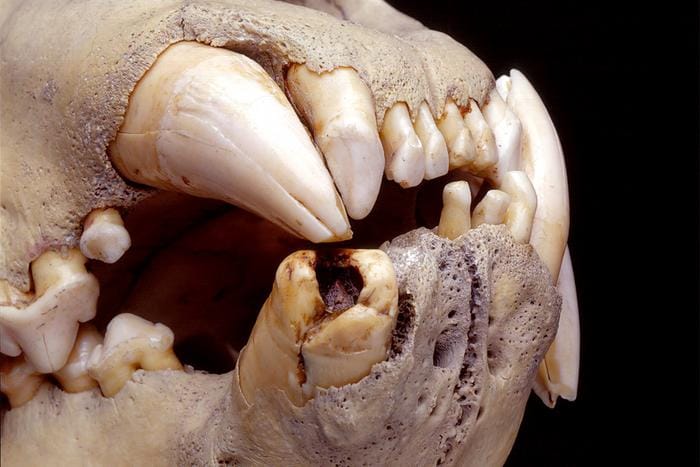Welcome back to the Abstract!
This week, for the first time, the column will only feature terrestrial news. Space will just have to wait, because too much weird stuff is going on right here at home, judging by new research into the oceans (snot-chutes and fusing jellies) and on land (finch songs from the future and humans on the menu). It’s always brat season on Earth, a glorious mess of a world.
The Future of Earth Hinges on…Sea Snow Snot
It’s always snowing in the ocean. Particles made of both dead and living organisms, plus a dash of poop, drift down from the surface, producing a steady precipitation of organic flakes. This “marine snow,” also known as “ocean dandruff,” is a critical factor in the global climate because these particles absorb a lot of atmospheric carbon from the surface.
As marine snow falls, the carbon it carries is either metabolized by creatures in the depths or it becomes sequestered in the seafloor. The process, known as the biological pump, is thought to lock up anywhere from two to 4.5 billion tons of carbon each year, removing a significant fraction of the roughly 10 billion tons of greenhouse gasses annually emitted by humans.
Now, scientists have discovered a hidden mechanism in marine snow that has upended our understanding of its dynamics—and its efficiency as a carbon hoarder. It turns out that the particles release tiny parachutes, made of mucus, that significantly slow their fall through ocean zones. A team captured these “invisible comets of mucus” for the first time with a rotating microscope while observing an algal bloom in the Gulf of Maine.
“Through detailed analysis of more than 100 marine snow aggregates studied individually, we discovered hidden comet tails that effectively act as ‘physical’ drag lines on sinking marine snow,” said Rahul Chajwa of Stanford University and colleagues. “This mucus-induced impedance almost doubles the estimate of mean residence time of marine snow in the Euphotic zone”—the upper part of the ocean that receives sunlight—”nearly halting some particles to a standstill."
First of all, let’s acknowledge that the phrase “mucus-induced impedance” is an excellent off-the-shelf insult. But more importantly, this discovery hints that marine snow may be locking up a lot less carbon than we expected because the snot-chutes enable particles to hang around in the upper ocean for longer periods, instead of quickly ferrying the gas down to the seafloor where it can be sequestered. The team warns of “a substantial overestimate” of the downward flux of carbon and, therefore, the biological pump’s efficiency.
“Given the current uncertainty in biological pump in a changing global climate, it is imperative to underpin the microbiology and microphysics of marine snow,” the team said. “Our direct in situ and on-vessel field setting measurements of a broad range of marine snow particles provide a promising approach to predictively understanding the biological pump.”
“The challenge of studying these highly heterogeneous aggregates arises from their biological richness and physical complexity,” they noted. “Every marine snow particle is biologically singular, with a plethora of planktonic species (both living and nonliving) and an associated bacterial and viral ecosystem.
In other words, your future, and the future of everyone you love, is partially contingent on the ornate booger comets in organic blizzards of the ocean. Godspeed.
‘Ghosts of Finches Future’
Charles Darwin famously used the variations in beak sizes of finches in the Galapagos Islands as evidence for evolution by natural selection. Evolutionary biologists have now upped the ante on Galapagos finch experiments by envisioning different beak shapes and sizes that might evolve in the birds in the future, and artificially generating the songs those beaks would produce. The artificial songs were then played to a bunch of finches to see if they would recognize the simulacrum of their future descendents. The finches were like, who dat? Science!
“We forecasted the acoustic structure of songs for a set of possible evolutionary futures (successive droughts spurring increasingly large beaks) and, in a field assay, presented resulting song simulations to territorial males,” said Jeffrey Podos and Katie Schroeder of the University of Massachusetts Amherst. “We found that responses to songs dropped off after six simulated drought events, to degrees roughly comparable to drops in response to songs that diverged through cultural drift and acoustic adaptation. Our results support, in Darwin’s finches, the feasibility and mechanistic bases of an ecological speciation hypothesis.”
Breakers Beware of “Headspin Hole” Before You Throw Down
Breakdancing may have been excised from the Olympic Games, but this week it made a memorable appearance in the annals of medical literature. Scientists reported a case report of “headspin hole,” one of many chronic afflictions known collectively as “breakdancer overuse syndrome.” Headspin hole, sometimes called “breakdance bulge” is characterized by “hair loss, inflammation, numbness, and sometimes formation of a lump on the scalp,” according to the new study. The breaker chronicled in this report grew a bump so big, surgery was required to remove it.
“We present a detailed case report of a male breakdancer in his early 30s who developed a noticeable scalp protuberance over 5 years of extensive headspinning practice,” said Mikkel Bundgaard Skotting at Copenhagen University and colleagues. “MRI showed significant subgaleal fibrosis and thickening of the subcutis, consistent with the ’cone-head sign’. The patient underwent successful surgical tumor removal, leading to aesthetic improvement and symptom relief.”
The Lion Eats (You) Tonight
Humans have mostly removed ourselves from the food chain with civilizational armor. But every now and then, we are reminded that many animals would have us for lunch if given the chance. Now is one of those times, as a DNA analysis of hair stuck in the teeth of two lions that lived in 1890s Kenya has been identified as belonging to some unfortunate human victims—in addition to many other meals. These Tsavo “man-eater” lions were known to have attacked humans at this time, an unusual behavior that may have been related to railway construction in the region.

“Analysis of hair DNA identified giraffe, human, oryx, waterbuck, wildebeest, and zebra as prey, and also identified hair that originated from lions,” said researchers led by Alida de Flamingh of the University of Illinois at Urbana-Champaign. “Our approach enables a better understanding of the hunting behaviors, diets, and ecology of historical individuals, populations, and species and holds promise for extinct populations and species.”
2 Become 1: Comb Jelly Version
Jokura, Kei et al., “Rapid physiological integration of fused ctenophores,” Current Biology
Finally, just so you know, comb jellies, a group of wobbly oval-shaped ctenophores found throughout the oceans, sometimes fuse together to form a single entity. Scientists who observed the phenomenon pondered whether these fusion events hint that comb jellies, which belong to a very ancient lineage, can’t tell themselves apart from their conspecifics.
“Here, we report that two injured Mnemiopsis leidyi individuals, a species of planktonic animals known as comb jellies or ctenophores, are capable of rapidly fusing into a single entity in which some physiological functions are integrated,” said Kei Jokura and colleagues of the University of Exeter.
“Ctenophores are among the earliest-branching animal groups of extant metazoans and possess a unique nervous system with enigmatic homology to other phyla,” the team said. “Our observations warrant further research into understanding the evolution of self–nonself recognition systems and the functional integration of neuronal structures in ctenophores.”
Thanks for reading!

